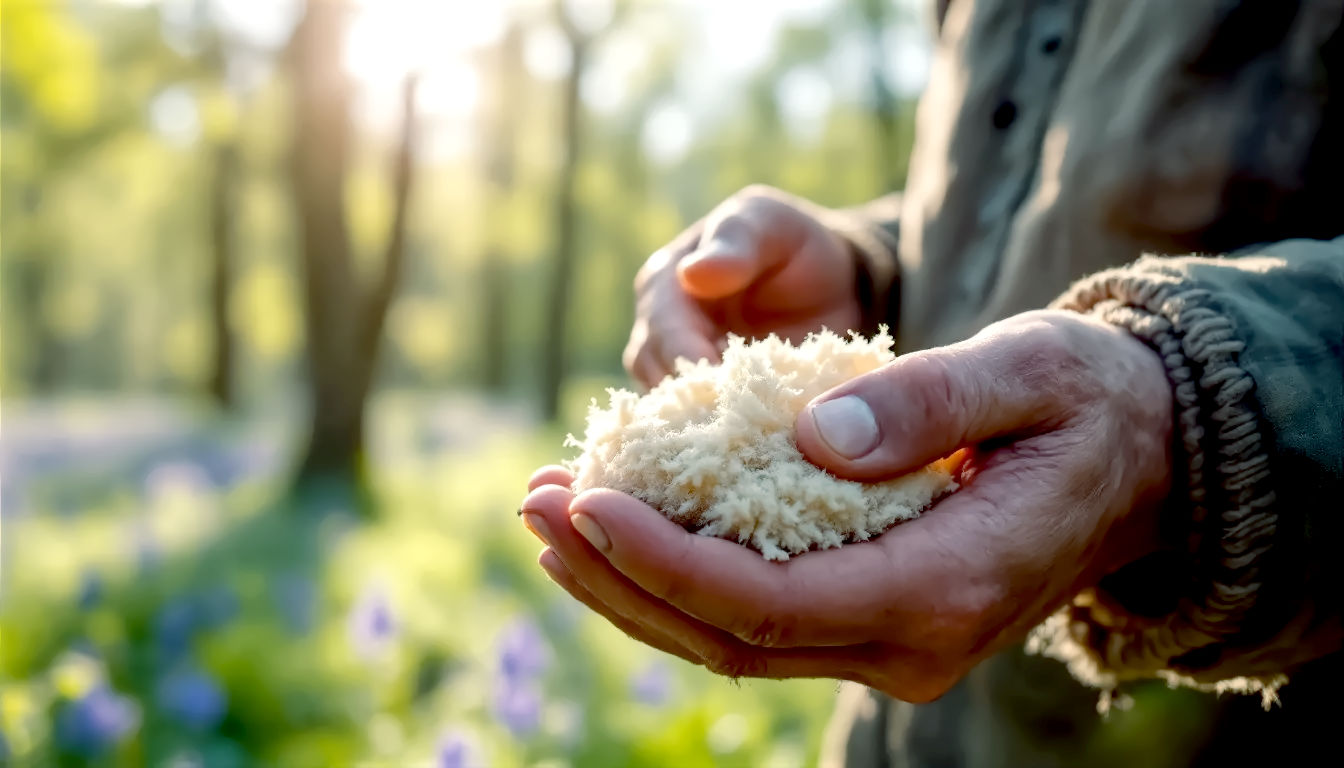The Lost Language of the Trees: Your Definitive Guide to Fluff, Tinder, Spoil, and Bumble Wood
Discover the lost language of the British countryside. This complete guide explores the forgotten meanings, uses, and ecology of fluff, tinder, spoil, and bumble wood.

This post may contain affiliate links. If you make a purchase through these links, we may earn a commission at no additional cost to you.
Walk into any British woodland today. What do you see? You’ll see trees, of course—the familiar oak, the silvery birch, the stoic beech. You’ll see a carpet of leaves, a smattering of bluebells in spring, and perhaps a shy robin watching you from a branch. But our ancestors saw something else. They saw a living library of resources, and they had a rich, practical language to describe it.
This wasn’t the formal Latin of botanists. It was a language of the hands and the hearth, a vocabulary built on centuries of experience. It was a way of looking at a fallen branch and knowing, instantly, if it would start a fire, build a shelter, feed a fungus, or house a queen bee. Today, most of that language is lost to us. We talk vaguely about ‘firewood’ or ‘rotten logs’, but the subtle distinctions have faded.
Four of these lost words are tinder wood, fluff wood, spoil wood, and bumble wood.
To us, they might sound like something from a children’s story. To a medieval forester, a Tudor wood-gatherer, or a Victorian charcoal-burner, they were terms of vital importance. They were the difference between a warm night and a cold one, a good day’s work and a wasted one.
This guide is your key to unlocking that lost language. We’re going to delve into what these four types of wood really are, how to find them, and why understanding them can change the way you see our beautiful British woodlands forever. It’s time to learn to read the woods again.
What is Tinder Wood? The Spark of Life
Let’s start with the one you might have heard of. If you’ve ever watched a survival programme or tried to light a campfire without a firelighter, you’ll know that tinder is essential. But what makes a piece of wood ‘tinder wood’?
The Simple Definition: More Than Just Sticks
At its core, tinder wood is any natural material that will catch a spark and burst into flame. It’s the very first step in making a fire from scratch. You can’t just hold a spark to a big log and hope for the best; it won’t work. You need an intermediary, something incredibly fine, dry, and flammable to turn that fleeting spark into a stable, baby flame. That’s the job of tinder.
Think of it like this:
- A spark is the idea.
- Tinder is the first scribbled note that captures the idea.
- Kindling (small twigs) is the first paragraph that expands on it.
- Fuel wood (logs) is the full story.
Without tinder, the idea of the fire simply vanishes. True tinder wood isn’t just any small, dry stick. It needs to have a huge surface area for its size, meaning it’s often fibrous, fluffy, or can be shaved into incredibly fine curls.
The Science Behind the Spark: Why Tinder Wood Works
It all comes down to a simple triangle: heat, fuel, and oxygen. To create a fire, you need enough heat to make the fuel release flammable vapours, which then mix with oxygen and ignite.
A big log is a massive bank of fuel, but it requires a huge amount of heat to get going. A spark, from a flint and steel or a fire steel, is intensely hot but only for a fraction of a second. It doesn’t have enough total energy to heat up a log.
Tinder wood solves this problem. Because it’s made of thousands of tiny fibres, it has a massive surface area exposed to the oxygen in the air. The tiny spark has enough energy to heat just one of these fibres to its ignition point. This creates a chain reaction, and the whole bundle of tinder catches, creating a small, stable flame that can then ignite your kindling.
The key properties of good tinder are:
- Dryness: It must be bone dry. Any moisture will absorb the spark’s heat and prevent ignition.
- Fine Texture: It must be fibrous, powdery, or in thin shavings to maximise surface area.
- Low Ignition Point: It must be a material that doesn’t need much persuading to catch fire.
Classic British Tinder Woods You Can Find Today
Our woodlands are full of fantastic tinder, if you know where to look.
- Silver Birch Bark: The undisputed king of British tinder. The paper-thin bark of the silver birch is rich in a flammable oil called betulin. It will light even when damp. You can gently peel off thin sheets from living trees without harming them. Never ring-bark a tree by taking a strip all the way around.
- King Alfred’s Cakes (Cramp Balls): These black, dome-shaped fungi (Daldinia concentrica) found on dead ash branches are another treasure. Once dried, the inside is like a dense, corky material. A spark caught in it will smoulder for hours, like a natural charcoal briquette. You can carry the ember with you to your next campsite.
- Fatwood: This is the resin-soaked heartwood from the stumps of pine trees. While less common in our native woods than in Scandinavia, you can sometimes find it in old Caledonian pine forests in Scotland. It’s waterproof and incredibly flammable.
- Clematis Bark: The fluffy, stringy bark of Old Man’s Beard (Clematis vitalba), a common climbing plant in southern England, makes for fantastic tinder when fluffed up into a bundle. Make sure it’s completely dry.
- Lime Tree Bast Fibre: The inner bark of the lime tree can be processed into fine, soft fibres that take a spark beautifully. This was a prized material for our ancestors, also used for making rope (or ‘bast’).
Finding and preparing tinder wood isn’t just a survival skill; it’s a way of connecting with the woods on a deeper level. It forces you to look closely, to understand the properties of different plants, and to appreciate the small details that our ancestors relied upon every single day.
What is Fluff Wood? The Gentle Art of Decay
Now we move into more obscure territory. Fluff wood is a term you won’t find in any modern forestry textbook. It describes a specific state of wood that is neither fresh nor completely rotten. It’s wood caught in a magical, transformative moment.
The Simple Definition: Soft, Spongy, and Deceiving
Fluff wood is wood that has been partially broken down by fungi, leaving it soft, light, and fibrous—almost like cotton wool or felt. It’s often pale in colour, very lightweight for its size, and you can easily crumble it or pull it apart with your fingers.
It’s the ghost of a branch. It still holds its shape, but its strength and substance are gone. You’ll often find it on fallen branches of deciduous trees like willow, poplar, and beech that have been lying on the damp woodland floor for a year or two.
Crucially, fluff wood is past the point of being useful as fuel. It won’t burn in the same way as solid wood. But it’s not yet the soggy, collapsing mess of spoil wood, either. It’s in-between.
The Fungal Architects: How Wood Becomes Fluff
The creator of fluff wood is fungus. Specifically, a type of fungus that causes something called white rot.
Wood is made of two main building blocks:
- Cellulose: Long, fibrous chains that give wood its structure and strength (like the steel frame of a building).
- Lignin: A complex compound that acts as the hard, rigid ‘glue’ holding the cellulose together (like the concrete).
White rot fungi are clever. They produce special enzymes (like tiny chemical scissors) that can break down both the tough lignin and the cellulose. As the lignin is removed, the pale, fibrous cellulose is left behind, creating that characteristic soft, ‘fluffy’ texture. It’s the process of deconstruction, artfully managed by nature’s finest recyclers.
When you pick up a piece of fluff wood, you’re holding the result of a microscopic battle that has been raging for months or years, a silent, slow-motion feast by the fungal kingdom.
Uses and Misuses: A Poor Fire but a Perfect Catcher
If you throw a piece of fluff wood on a roaring fire, you’ll be disappointed. It will smoulder, smoke, and vanish with very little heat output. Its density is gone. It’s a bit of a let-down as firewood.
But it has one very specific, brilliant use in fire-lighting.
While it won’t hold a flame well, fluff wood is one of the best materials for catching a spark. Think of it as a natural alternative to cotton wool. If you can find a piece of bone-dry fluff wood and aim your spark into it, it will catch and begin to glow with a persistent ember. This is because, like tinder, its fibrous structure gives it a huge surface area.
The technique is to catch the spark in the fluff wood, gently fold the wood around the glowing ember, and blow it into flame. It acts as a ‘tinder extender’ or a bed for your spark. So, while it’s not tinder wood itself, it’s a crucial part of the tinder bundle.
It was also historically used for other purposes:
- Insulation: Packed into cracks in primitive shelters.
- Wound Dressing: Its soft, absorbent nature made it a passable field dressing in emergencies.
- Tinderboxes: Charred fluff wood (making ‘char cloth’) was a key component of the classic tinstone tinderbox, as it would hold a spark with incredible reliability.
So don’t dismiss that pale, soft branch. It’s not just decaying wood; it’s potential.
What is Spoil Wood? The Gardener’s Friend, The Fire’s Foe
The name says it all. Spoil wood is, quite simply, wood that has ‘gone off’. It’s spoiled for its primary human purpose, which for centuries was burning for heat or cooking.
The Simple Definition: Wood That Won’t Work
Spoil wood is wood that is too rotten, wet, or otherwise degraded to be used effectively as firewood. It’s the end of the line in the decay process. Where fluff wood is soft but often dry, spoil wood is typically sodden, heavy with water, and structurally weak. It will collapse into a mushy pile if you put any pressure on it.
When you see a log that is dark, wet, and teeming with worms, slugs, and centipedes, you’re looking at spoil wood. It’s no longer a log; it’s becoming soil. Trying to burn it would be like trying to burn a bucket of mud. You’ll get a lot of hiss, steam, and smoke, but almost no heat. It simply consumes more energy to dry out than it releases by burning.
The Many Faces of Spoil Wood
Not all spoil wood is the same. It can be ‘spoiled’ for several reasons:
- Too Rotten (Brown Rot): While white rot creates fluff wood, another process called brown rot results in a different kind of decay. Brown rot fungi only eat the cellulose, leaving the crumbly, brown lignin behind. This wood breaks into cubical chunks and has no fibrous strength. It’s useless for fire.
- Too Wet (Waterlogged): A perfectly good piece of hardwood can become spoil wood simply by falling into a stream or lying in a boggy patch of ground. It becomes so saturated with water that it would take months to dry out, by which time fungi will have already started to invade.
- Too Green: Freshly cut, or ‘green’, wood is also technically a form of temporary spoil wood from a fire-making perspective. It’s full of sap and water (up to 50% of its weight) and needs to be seasoned (left to dry for 6-18 months) before it can be burned efficiently.
- The Wrong Type: Some trees just produce poor firewood. For example, Horse Chestnut wood spits and sparks dangerously, while many coniferous woods like pine burn very fast and produce a lot of tar that can clog up a chimney. For someone with a specific need, these could be considered ‘spoil wood’.
From Waste to Wonder: The Ecological Power of Spoil Wood
For our ancestors focused on survival, spoil wood was a nuisance. For a modern ecologist, it’s a treasure trove. Spoil wood, or deadwood as we now call it, is one of the most important features of a healthy woodland ecosystem.
Calling it ‘spoil’ wood reveals a purely human-centric view. From nature’s perspective, it’s anything but spoiled.
- It’s a Wildlife Hotel: A single decaying log can provide a home for a staggering variety of life. Mosses, lichens, and fungi colonise the surface. Beetles, like the magnificent Stag Beetle, lay their eggs in it. Centipedes and woodlice take shelter in its cracks. Frogs, toads, and even slow-worms will hibernate underneath it.
- It’s a Nutrient Bank: As the wood breaks down, it slowly releases its stored nutrients back into the ground, fertilising the soil and feeding the next generation of trees. It’s the woodland’s own composting and recycling system.
- It’s a Water Reservoir: A spongy, rotting log acts like a natural sponge, soaking up rainwater and releasing it slowly. This helps to keep the woodland floor moist during dry spells and regulates the local water cycle.
Modern gardeners are now rediscovering the value of spoil wood through practices like Hügelkultur, where large piles of logs and branches are buried under soil to create incredibly fertile, water-retentive raised beds.
So, the next time you see a messy, rotting log on the forest floor, don’t see it as waste. See it for what it really is: a bustling city of insects, a pantry for fungi, and the foundation of the forest’s future.
What is Bumble Wood? A Sweet Secret of the Hedgerow
This is perhaps the most charming and obscure of the four terms. Bumble wood is a wonderful piece of countryside folklore, a word that speaks of a close, observant relationship with nature’s smallest inhabitants.
The Simple Definition: A Home, Not a Hearth
Bumble wood is wood that has been hollowed out by insects or natural decay, creating cavities that are often used as nesting sites by bumblebees and other creatures.
The name most likely comes from its direct association with bumblebees, which, unlike honeybees, don’t build large, waxy hives. Many species of bumblebee are cavity nesters. A queen emerging from hibernation will actively search for a small, dry, protected hole to start her new colony. An old mouse hole is a favourite, but a hollow, decaying piece of wood is just as good.
So, bumble wood isn’t defined by its state of decay (though it is often partially rotten), but by its structure. It is wood that has become a vessel for life. It’s wood with rooms to let.
The Bee Connection: More Than Just a Name?
The link is clear. A fallen willow branch, whose soft wood rots from the inside out, can become a perfect piece of bumble wood. Woodpeckers will drill holes in dead trees, which are then abandoned and taken over by other tenants. The larvae of certain beetles will bore intricate tunnels, creating a network of ready-made bee apartments.
Finding a piece of bumble wood in late spring might reward you with the gentle, industrious hum of a fledgling bee colony. It’s a sign that the woodland is not just a collection of plants, but a functioning community of interconnected lives.
While primarily associated with bees, the term could also encompass wood used by other creatures:
- Wrens: These tiny birds love to build their domed, mossy nests in holes in old trees and logs.
- Wood Mice: A hollow log provides a perfect, defensible home.
- Solitary Wasps: Many non-aggressive species of solitary wasp use hollow stems and beetle holes to lay their eggs.
Finding Bumble Wood: A Sign of a Healthy Woodland
You won’t find bumble wood in a neat, commercially managed forest where every dead tree is cleared away. You’ll find it in old, unkempt woodlands, in mature hedgerows, and in forgotten corners of parks and large gardens.
Look for fallen branches of softwoods like willow, poplar, or sycamore. Look for standing deadwood (if it’s safe and not at risk of falling on you) with old woodpecker holes in it. The presence of bumble wood is a fantastic indicator of a healthy, biodiverse environment. It means you have a good population of insects, birds, and the fungi that are needed to create these valuable hollows in the first place.
Like spoil wood, bumble wood has no value for burning. Its value lies in the life it supports. It’s a reminder that sometimes, the most useful thing a piece of wood can do is absolutely nothing, except sit there and be a home.
The Woodland Detective: A Practical Guide to Identification
Now that you know the theory, it’s time to get practical. How can you walk into a wood and tell these four types apart? Here are a few simple, hands-on tests you can perform.
A Four-Step Field Test
- The Snap Test: Pick up a likely-looking branch of a manageable size. Try to snap it.
- Sharp, Loud ‘CRACK’: This is solid, seasoned wood. Good for fuel. It’s none of our four types.
- Bends, then Tears with a Fibrous Rip: This could be green wood (a type of temporary spoil wood).
- Crumbles or Breaks with a Dull, Soft Tear: You’re likely holding Fluff Wood. You’ll feel the lack of structural integrity.
- Completely Sags or Falls Apart in Your Hands: This is Spoil Wood. It has no strength left.
- The Weight Test: Pick up the piece of wood. Does it feel as heavy as it looks?
- Surprisingly Heavy: It’s likely either green wood or waterlogged Spoil Wood. The weight comes from water.
- Surprisingly Light: It’s almost certainly Fluff Wood. The fungi have consumed its density, leaving a lightweight, airy structure.
- The Feel and Texture Test: Run your hands over the wood.
- Hard and Smooth/Rough: Good, solid wood.
- Soft, Fibrous, Almost Fabric-Like: This is the classic sign of Fluff Wood.
- Damp, Spongy, or Crumbly and Muddy: This is Spoil Wood.
- Holes, Tunnels, and Hollows: You’ve found Bumble Wood. Check for signs of residents!
- The Bark Test: Look at the bark.
- Tightly Attached: The wood is likely fresh or well-seasoned.
- Peeling Away Easily: The wood is starting to decay. This is common on both Fluff and Spoil Wood.
- Paper-Thin and Peeling (on a Birch): This is your prime Tinder Wood.
A Quick Reference Chart
| Wood Type | Key Characteristic | Feels Like… | Burns… | Ecological Role |
|---|---|---|---|---|
| Tinder Wood | Very fine, dry, flammable | Papery, fibrous, dusty | Instantly, with a flame | Fire-starting material |
| Fluff Wood | Pale, light, soft, fibrous | Cotton wool, felt | Poorly, smoulders | Catches a spark, becomes char cloth, insulation |
| Spoil Wood | Wet, heavy, dark, crumbling | A damp sponge, mud | Not at all (just smokes) | Nutrient cycling, water retention, insect habitat |
| Bumble Wood | Hollowed out with cavities | Hard or soft, but with holes | Not applicable | Nesting sites for bees, birds, and insects |
Beyond Definitions: Reclaiming Our Woodland Literacy
Understanding the difference between fluff wood and spoil wood might not seem important in a world of central heating and gas hobs. But these words, and the concepts behind them, are more than just trivia for bushcraft enthusiasts.
They represent a form of ‘woodland literacy’. They are a reminder of a time when people lived in a much closer, more intimate partnership with the natural world. This language didn’t come from textbooks; it was earned through observation, through trial and error, through the daily necessity of staying warm, fed, and sheltered.
Losing these words is like losing the subtle flavours in a complex recipe. We can still eat, but the experience is poorer. When we can only say ‘rotten wood’, we lump together the potential tinder-helper (fluff wood), the soil-creator (spoil wood), and the bee-nursery (bumble wood) into one useless category. We fail to see the intricate processes and possibilities in front of us.
By relearning this language, we enrich our own experience of the outdoors. A walk in the woods becomes a treasure hunt. Every fallen log is a story waiting to be read. Is it a story of fungal artistry? A story of future soil? Or a story with a gentle hum coming from inside?
This knowledge doesn’t ask us to abandon our modern comforts. It simply invites us to look a little closer, to pay attention, and to see the woodland not as a pretty backdrop, but as a complex, living system full of purpose and wonder.
Conclusion: More Than Just Wood
From the fiery potential of tinder wood to the gentle decay of fluff wood, the soggy collapse of spoil wood, and the hidden life within bumble wood, we’ve travelled back in time. We’ve rediscovered a language that turns a simple walk in the woods into a conversation.
These terms show us that nothing in nature is ever truly wasted. Wood that is ‘spoiled’ for one purpose is perfect for another. A branch that is too soft to burn might be the perfect nursery for a spark. A log too rotten for a fire becomes the heart of the forest’s regeneration. And a hollowed-out trunk becomes a home.
So the next time you are out, under the canopy of a great British woodland, stop. Pick up a fallen branch. Feel its weight, test its strength, look for the tell-tale signs. Ask yourself: what is this wood’s story? Is it tinder, fluff, spoil, or bumble?
You might be surprised by how much the trees have to tell you, now that you know how to listen.
Further Reading
To continue your journey into understanding our woodlands, we recommend these highly respected resources:
- The Woodland Trust – The UK’s largest woodland conservation charity, with extensive information on British trees and woodland ecology.
- Forestry England – Manages England’s public forests, offering resources on sustainable forestry and wildlife.
- Ray Mears & Woodlore – A world-renowned authority on Bushcraft and survival skills, with excellent practical advice on fire-lighting and natural materials.
- The British Mycological Society – For those wishing to dive deeper into the fascinating world of fungi and their role in wood decay.






